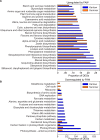Fall armyworm (Spodoptera frugiperda Smith) feeding elicits differential defense responses in upland and lowland switchgrass
- PMID: 31194847
- PMCID: PMC6564039
- DOI: 10.1371/journal.pone.0218352
Fall armyworm (Spodoptera frugiperda Smith) feeding elicits differential defense responses in upland and lowland switchgrass
Abstract
Switchgrass (Panicum virgatum L.) is a low input, high biomass perennial grass being developed for the bioenergy sector. Upland and lowland cultivars can differ in their responses to insect herbivory. Fall armyworm [FAW; Spodoptera frugiperda JE Smith (Lepidoptera: Noctuidae)] is a generalist pest of many plant species and can feed on switchgrass as well. Here, in two different trials, FAW larval mass were significantly reduced when fed on lowland cultivar Kanlow relative to larvae fed on upland cultivar Summer plants after 10 days. Hormone content of plants indicated elevated levels of the plant defense hormone jasmonic acid (JA) and its bioactive conjugate JA-Ile although significant differences were not observed. Conversely, the precursor to JA, 12-oxo-phytodienoic acid (OPDA) levels were significantly different between FAW fed Summer and Kanlow plants raising the possibility of differential signaling by OPDA in the two cultivars. Global transcriptome analysis revealed a stronger response in Kanlow plant relative to Summer plants. Among these changes were a preferential upregulation of several branches of terpenoid and phenylpropanoid biosynthesis in Kanlow plants suggesting that enhanced biosynthesis or accumulation of antifeedants could have negatively impacted FAW larval mass gain on Kanlow plants relative to Summer plants. A comparison of the switchgrass-FAW RNA-Seq dataset to those from maize-FAW and switchgrass-aphid interactions revealed that key components of plant responses to herbivory, including induction of JA biosynthesis, key transcription factors and JA-inducible genes were apparently conserved in switchgrass and maize. In addition, these data affirm earlier studies with FAW and aphids that the cultivar Kanlow can provide useful genetics for the breeding of switchgrass germplasm with improved insect resistance.
Conflict of interest statement
The authors have declared that no competing interests exist.
Figures




Similar articles
-
Differential Defense Responses of Upland and Lowland Switchgrass Cultivars to a Cereal Aphid Pest.Int J Mol Sci. 2020 Oct 27;21(21):7966. doi: 10.3390/ijms21217966. Int J Mol Sci. 2020. PMID: 33120946 Free PMC article.
-
Effect of Switchgrass Ecotype and Cultivar on Establishment, Feeding, and Development of Fall Armyworm (Lepidoptera: Noctuidae).J Econ Entomol. 2019 Feb 12;112(1):440-449. doi: 10.1093/jee/toy292. J Econ Entomol. 2019. PMID: 30346580
-
Contrasting metabolism in perenniating structures of upland and lowland switchgrass plants late in the growing season.PLoS One. 2014 Aug 18;9(8):e105138. doi: 10.1371/journal.pone.0105138. eCollection 2014. PLoS One. 2014. PMID: 25133804 Free PMC article.
-
Exploring Metabolomics to Innovate Management Approaches for Fall Armyworm (Spodoptera frugiperda [J.E. Smith]) Infestation in Maize (Zea mays L.).Plants (Basel). 2024 Sep 2;13(17):2451. doi: 10.3390/plants13172451. Plants (Basel). 2024. PMID: 39273935 Free PMC article. Review.
-
Host plant resistance for fall armyworm management in maize: relevance, status and prospects in Africa and Asia.Theor Appl Genet. 2022 Nov;135(11):3897-3916. doi: 10.1007/s00122-022-04073-4. Epub 2022 Mar 23. Theor Appl Genet. 2022. PMID: 35320376 Free PMC article. Review.
Cited by
-
Integrated Transcriptome and Metabolome Analysis to Identify Sugarcane Gene Defense against Fall Armyworm (Spodoptera frugiperda) Herbivory.Int J Mol Sci. 2022 Nov 8;23(22):13712. doi: 10.3390/ijms232213712. Int J Mol Sci. 2022. PMID: 36430189 Free PMC article.
-
Genomic Analysis of Resistance to Fall Armyworm (Spodoptera frugiperda) in CIMMYT Maize Lines.Genes (Basel). 2022 Jan 28;13(2):251. doi: 10.3390/genes13020251. Genes (Basel). 2022. PMID: 35205295 Free PMC article.
-
Structural Similarities and Overlapping Activities among Dihydroflavonol 4-Reductase, Flavanone 4-Reductase, and Anthocyanidin Reductase Offer Metabolic Flexibility in the Flavonoid Pathway.Int J Mol Sci. 2023 Sep 9;24(18):13901. doi: 10.3390/ijms241813901. Int J Mol Sci. 2023. PMID: 37762209 Free PMC article.
-
Aphid-Responsive Defense Networks in Hybrid Switchgrass.Front Plant Sci. 2020 Jul 30;11:1145. doi: 10.3389/fpls.2020.01145. eCollection 2020. Front Plant Sci. 2020. PMID: 32849703 Free PMC article.
-
Differential Defense Responses of Upland and Lowland Switchgrass Cultivars to a Cereal Aphid Pest.Int J Mol Sci. 2020 Oct 27;21(21):7966. doi: 10.3390/ijms21217966. Int J Mol Sci. 2020. PMID: 33120946 Free PMC article.
References
-
- Bartley L, Wu Y, Saathoff A, Sarath G. Switchgrass Genetics and Breeding Challenges. John Wiley and Sons; 2013. p. 7–31.
-
- Calles Torrez V, Johnson PJ, Boe A. Infestation Rates and Tiller Morphology Effects by the Switchgrass Moth on Six Cultivars of Switchgrass. Bioenergy Research. 2013;6(2):808–12.
Publication types
MeSH terms
Substances
Grants and funding
LinkOut - more resources
Full Text Sources

